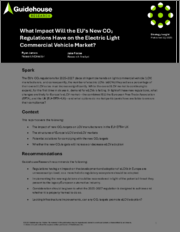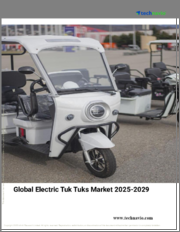
|
시장보고서
상품코드
1529072
세계의 소형 상용차 시장 규모 : 차량별, 총중량별, 연료별, 용도별 - 예측(2024-2032년)Light Commercial Vehicle Market Size - By Vehicle (Pickup trucks, Vans, Light-duty trucks), By Gross Weight (6000 - 9000 lbs, 9000 - 12000 lbs, 12000 - 14000 lbs), By Fuel, By Application, Forecast 2024 - 2032 |
||||||
소형 상용차 시장 규모는 자금 조달 증가와 신제품 출시 급증으로 2024년부터 2032년까지 연평균 8% 이상의 성장률을 나타낼 것으로 예상됩니다.
기업들은 효율적인 운송 솔루션에 대한 수요 증가에 대응하기 위해 혁신적인 소형 상용차(LCV) 개발에 투자하고 있습니다. 그 결과, 첨단 기능을 탑재한 새로운 모델들이 속속 출시되고 있습니다. 또한, 급속한 기술 발전은 제품 라인업을 확장하고 업계 성장을 위한 새로운 기회를 창출하고 있습니다. 예를 들어, 2024년 5월 힌두야 그룹의 주력 기업인 아쇼크 레이랜드(Ashok Leyland)는 LCV 시장 점유율을 20%에서 25%로 확대하는 것을 목표로 12개월 동안 6대의 새로운 소형 상용차(2-3.5톤)를 출시할 것이라고 발표했습니다.
픽업트럭 차량 부문 시장 점유율은 다양한 작업에 대한 채택이 증가함에 따라 2024년부터 2032년까지 양호한 성장률을 나타낼 것으로 예상됩니다. 픽업트럭은 견인력 강화 및 연비 향상과 같은 첨단 기능으로 진화하고 있습니다. 제조업체들은 또한 미래의 환경 기준을 충족하기 위해 보다 지속 가능한 소재를 통합하고 전기 모델을 개발하고 있습니다. 이 차량들은 또한 효율적인 물자 운송을 보장하기 위해 건설에서 물류에 이르기까지 다양한 산업에 기여하고 있습니다.
용도별로는 건설 및 광업 분야의 LCV 시장이 2024-2032년 상당한 CAGR을 나타낼 것으로 예측됩니다. 건설 및 광업 분야의 소형 상용차는 험준한 지형을 견딜 수 있도록 견고한 섀시와 강력한 엔진을 광범위하게 장착하고 있습니다. 또한, 첨단 안전 기능과 실시간 작업 모니터링을 위한 텔레매틱스 기능도 탑재되어 있습니다. 또한, 이 차량들은 열악한 환경에서도 보다 안전하고 정확하게 조종할 수 있는 자율 주행 기능을 통합하고 있습니다.
북미 소형 상용차 산업은 경제 성장과 정부 지원 정책으로 인해 2032년까지 높은 CAGR을 나타낼 것입니다. 기업들은 차량의 효율성을 높이고 탄소 배출량을 줄이기 위해 연구개발에 투자하고 있습니다. 정부 이니셔티브는 인센티브와 규제 프레임워크를 통해 전기차와 하이브리드 자동차의 채택을 촉진하고 있습니다. 경제 상황이 개선됨에 따라 LCV 부문은 대륙 전체에서 일자리 창출과 인프라 개발에 기여하고 시장 성장을 가속할 것입니다.
목차
제1장 조사 방법과 조사 범위
제2장 주요 요약
제3장 업계 인사이트
- 생태계 분석
- 공급업체 상황
- 원재료 공급업체
- 부품 공급업체
- 제조업체
- 기술 파트너
- 최종사용자
- 이익률 분석
- 기술 및 혁신 전망
- 특허 분석
- 주요 뉴스 및 이니셔티브
- 규제 상황
- 영향요인
- 성장 촉진요인
- 업계의 잠재적 리스크&과제
- 성장 가능성 분석
- Porter's Five Forces 분석
- PESTEL 분석
제4장 경쟁 구도
- 서론
- 기업 점유율 분석
- 경쟁 포지셔닝 매트릭스
- 전략 전망 매트릭스
제5장 시장 추산·예측 : 차량별, 2021-2032년
- 주요 동향
- 픽업 트럭
- 밴
- 소형 트럭
제6장 시장 추산·예측 : 총중량별, 2021-2032년
- 주요 동향
- 6000-9000파운드
- 9000-12000파운드
- 12000-14000파운드
제7장 시장 추산·예측 : 연료별, 2021-2032년
- 주요 동향
- 가솔린
- 디젤
- 전기
제8장 시장 추산·예측 : 용도별, 2021-2032년
- 주요 동향
- 물류 및 운송
- 건설 및 광업
- 유틸리티 서비스
- 렌탈 및 리스
제9장 시장 추산·예측 : 지역별, 2021-2032년
- 주요 동향
- 북미
- 미국
- 캐나다
- 유럽
- 영국
- 독일
- 프랑스
- 이탈리아
- 스페인
- 러시아
- 기타 유럽
- 아시아태평양
- 중국
- 인도
- 일본
- 한국
- 뉴질랜드
- 동남아시아
- 기타 아시아태평양
- 라틴아메리카
- 브라질
- 멕시코
- 아르헨티나
- 기타 라틴아메리카
- 중동 및 아프리카
- 아랍에미리트(UAE)
- 남아프리카공화국
- 사우디아라비아
- 기타 중동 및 아프리카
제10장 기업 개요
- Citroen
- Fiat Chrysler Automobiles
- Ford Motor Company
- Foton
- General Motors(Chevrolet and GMC)
- Hino
- Isuzu Commercial Truck of America
- IVECO
- Mercedes-Benz
- Mitsubishi Fuso
- Nissan
- Peugeot
- Scania
- Toyota
- Volkswagen Group
- Volvo Trucks
Light Commercial Vehicle Market size is set to record over 8% CAGR from 2024 to 2032 due to increasing funding and the surge in new product launches. Companies are investing in developing innovative light commercial vehicles (LCVs) to meet the growing demand for efficient transportation solutions. As a result, they are introducing new models equipped with advanced features. The rapid technological advancements are also expanding product offerings, creating new opportunities for industry growth. For instance, in May 2024, Ashok Leyland, the Hinduja Group flagship announced to launch of six new light commercial vehicles (2-3.5 tonnes) over 12 months while targeting an increase in its LCV market share from 20% to 25%.
The light commercial vehicle industry is segmented into vehicle, capacity, fuel, application, and region.
The market share from the pickup trucks vehicle segment will record a decent growth rate between 2024 and 2032, due to rising adoption for various tasks. Pickup trucks are evolving with advanced features like enhanced towing capacities and improved fuel efficiency. Manufacturers are also integrating more sustainable materials and developing electric models to meet future environmental standards. These vehicles are further serving diverse industries from construction to logistics for ensuring efficient transportation of goods.
In terms of application, the LCV market from the construction & mining segment is anticipated to witness a significant CAGR from 2024-2032. Light commercial vehicles in construction and mining are widely equipped with robust chassis and powerful engines to withstand rugged terrains. They are also incorporated with advanced safety features and telematics for real-time monitoring of operations. In addition, these vehicles are integrating autonomous functionalities to allow safer and more precise maneuvers in challenging environments.
North America light commercial vehicle industry size will record significant CAGR through 2032 due to economic growth and supportive government policies. Companies are investing in R&D to enhance vehicle efficiency and reduce carbon footprints. Government initiatives are promoting the adoption of electric and hybrid vehicles through incentives and regulatory frameworks. As economic conditions are improving, the LCV sector will be contributing to job creation and infrastructure development across the continent, favoring market growth.
Table of Contents
Chapter 1 Methodology & Scope
- 1.1 Market scope & definitions
- 1.2 Research design
- 1.2.1 Research approach
- 1.2.2 Data collection methods
- 1.3 Base estimates & calculations
- 1.3.1 Base year calculation
- 1.3.2 Key trends for market estimation
- 1.4 Forecast model
- 1.5 Primary research and validation
- 1.5.1 Primary sources
- 1.5.2 Data mining sources
Chapter 2 Executive Summary
- 2.1 Industry 360° synopsis, 2021 - 2032
Chapter 3 Industry Insights
- 3.1 Industry ecosystem analysis
- 3.2 Supplier landscape
- 3.2.1 Raw material supplier
- 3.2.2 Component supplier
- 3.2.3 Manufacturers
- 3.2.4 Technology partners
- 3.2.5 End users
- 3.3 Profit margin analysis
- 3.4 Technology & innovation landscape
- 3.5 Patent analysis
- 3.6 Key news & initiatives
- 3.7 Regulatory landscape
- 3.8 Impact forces
- 3.8.1 Growth drivers
- 3.8.1.1 Increasing need for local goods transport
- 3.8.1.2 Demand for efficient last-mile delivery
- 3.8.1.3 Expansion of road networks boosts demand
- 3.8.1.4 Adoption of electric and hybrid powertrains
- 3.8.2 Industry pitfalls & challenges
- 3.8.2.1 Increased operational costs for fleets
- 3.8.2.2 Rapid advancements require frequent upgrades
- 3.8.1 Growth drivers
- 3.9 Growth potential analysis
- 3.10 Porter's analysis
- 3.11 PESTEL analysis
Chapter 4 Competitive Landscape, 2023
- 4.1 Introduction
- 4.2 Company market share analysis
- 4.3 Competitive positioning matrix
- 4.4 Strategic outlook matrix
Chapter 5 Market Estimates & Forecast, By Vehicle 2021 - 2032 ($Bn, Units)
- 5.1 Key trends
- 5.2 Pickup trucks
- 5.3 Vans
- 5.4 Light-duty trucks
Chapter 6 Market Estimates & Forecast, By Gross Weight, 2021 - 2032 ($Bn, Units)
- 6.1 Key trends
- 6.2 6000 - 9000 lbs.
- 6.3 9000 - 12000 lbs.
- 6.4 12000 - 14000 lbs.
Chapter 7 Market Estimates & Forecast, By Fuel, 2021 - 2032 ($Bn, Units)
- 7.1 Key trends
- 7.2 Gasoline
- 7.3 Diesel
- 7.4 Electric
Chapter 8 Market Estimates & Forecast, By Application, 2021 - 2032 ($Bn, Units)
- 8.1 Key trends
- 8.2 Logistics & transportation
- 8.3 Construction & mining
- 8.4 Utility services
- 8.5 Rental & leasing
Chapter 9 Market Estimates & Forecast, By Region, 2021 - 2032 ($Bn, Units)
- 9.1 Key trends
- 9.2 North America
- 9.2.1 U.S.
- 9.2.2 Canada
- 9.3 Europe
- 9.3.1 UK
- 9.3.2 Germany
- 9.3.3 France
- 9.3.4 Italy
- 9.3.5 Spain
- 9.3.6 Russia
- 9.3.7 Rest of Europe
- 9.4 Asia Pacific
- 9.4.1 China
- 9.4.2 India
- 9.4.3 Japan
- 9.4.4 South Korea
- 9.4.5 ANZ
- 9.4.6 Southeast Asia
- 9.4.7 Rest of Asia Pacific
- 9.5 Latin America
- 9.5.1 Brazil
- 9.5.2 Mexico
- 9.5.3 Argentina
- 9.5.4 Rest of Latin America
- 9.6 MEA
- 9.6.1 UAE
- 9.6.2 South Africa
- 9.6.3 Saudi Arabia
- 9.6.4 Rest of MEA
Chapter 10 Company Profiles
- 10.1 Citroen
- 10.2 Fiat Chrysler Automobiles
- 10.3 Ford Motor Company
- 10.4 Foton
- 10.5 General Motors (Chevrolet and GMC)
- 10.6 Hino
- 10.7 Isuzu Commercial Truck of America
- 10.8 IVECO
- 10.9 Mercedes-Benz
- 10.10 Mitsubishi Fuso
- 10.11 Nissan
- 10.12 Peugeot
- 10.13 Scania
- 10.14 Toyota
- 10.15 Volkswagen Group
- 10.16 Volvo Trucks



















